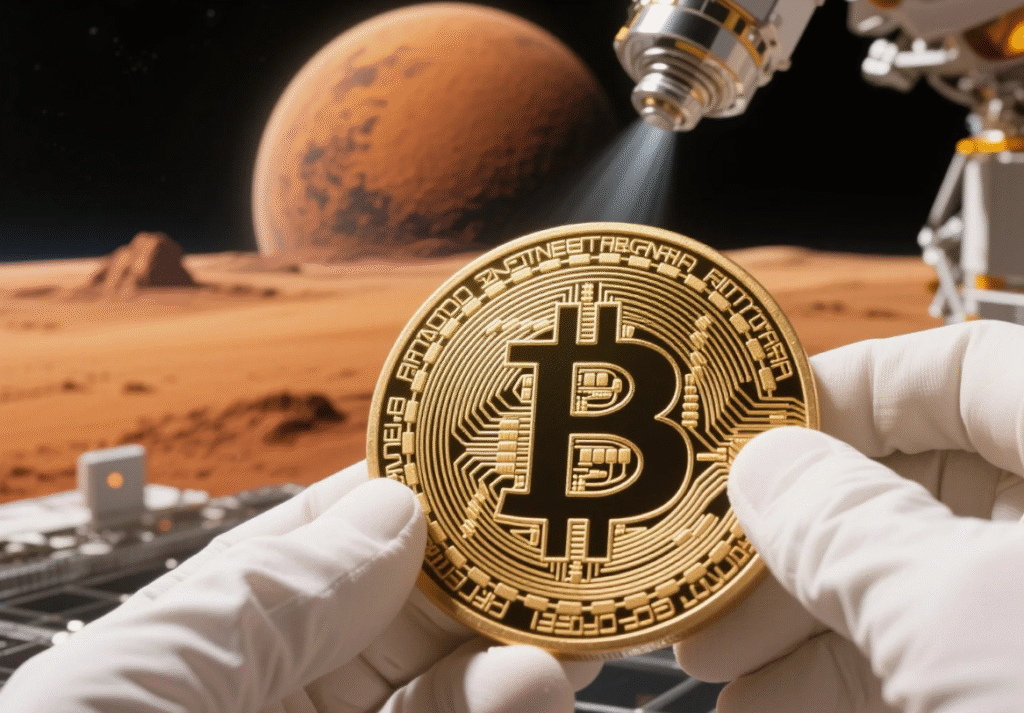Sending BTC to Mars: Researchers Outline How It Could Work
Don’t just sign up — trade smarter and save 20% with referral codes: Binance WZ9KD49N / OKX 26021839
Introduction

- Overview of research on Bitcoin Mars transactions: Exploring the potential to extend Bitcoin transactions between Earth and Mars
- Key question: Are interplanetary transactions truly feasible?
The Concept of Interplanetary Bitcoin
Core Mechanics of Blockchain (Consensus and Confirmation Times)
- Bitcoin’s blockchain relies on Proof-of-Work consensus, with an average block confirmation time of 10 minutes
- Interplanetary conditions could delay confirmations due to data transmission lag
Why Bitcoin Transactions to Mars Pose Unique Challenges (Latency and Bandwidth)
- One-way communication delay between Earth and Mars ranges from 3 to 22 minutes, with round-trip times up to 44 minutes
- Limited bandwidth and periodic communication blackouts (e.g., 2-week disruptions every 26 months) hinder network sync
Starting Point of the Theoretical Research
- Research by Jose Puente and Carlos Puente proposes Bitcoin as a standard interplanetary currency, using Proof-of-Transit Timestamping (PoTT) to track transactions via satellites and relays
Technical Challenges
Lightspeed Latency (Earth–Mars Average of 3–22 Minutes)
- Average 12.5-minute light-speed delay disrupts block mining and confirmation sync between planets
- Mars miners could lag 1–3 blocks behind Earth, causing frequent chain reorganizations
Node Synchronization Issues (Mars Chain vs. Earth Chain)
- Mars nodes would have a delayed blockchain view, reducing mining efficiency and increasing fork risks
- Solutions like atomic clocks and quantum communication could minimize latency
Security and Potential Attack Vectors
- 51% attacks become easier due to latency, with “space pirates” potentially leveraging solar energy for hash power dominance
- Risks from cosmic radiation and communication blackouts
Network Infrastructure Needs (Satellites and Interplanetary Internet)
- Relies on Starlink, NASA’s Deep Space Network, or relay satellites for header-first data transmission
Proposed Solutions
Local Chain (Mars Running an Independent Bitcoin Fork/Sidechain)
- A sidechain pegged 1:1 to Earth’s main chain, using federations or blind-merge-mining (BMM) for large settlements
- Enables fast local transactions on Mars without real-time Earth sync
Cross-Chain Communication Protocols (Interplanetary Settlement Layer)
- PoTT acts as a “receipt” layer to timestamp transactions via intermediary relays, ensuring data integrity
- Integration with Lightning Network for long-term channels and planetary watchtowers
Delay-Tolerant Algorithms (DTN – Delay-Tolerant Networking)
- DTN manages disrupted networks, paired with Bundle Protocol (BPv7) for data transfer via LEO mesh constellations
- PoTT testing is feasible today with stable Earth–Mars links
Potential “Mars Miners” Ecosystem
- Mars miners could use solar energy, connecting to Earth’s network via relays to avoid profit loss from latency
Why It Matters Beyond Science Fiction
Blockchain’s Role in Future Space Colony Financial Infrastructure
- Bitcoin offers a decentralized, transparent currency for interplanetary commerce, eliminating intermediaries
- Supports tokenization of space assets and smart contracts for colonial logistics
Decentralized Currency vs. Planetary Economic Systems
- Bitcoin could bridge Earth–Mars economies, with Marscoin as a potential local variant
- Mitigates inflation risks from abundant space resources like gold
Space Exploration Tech Breakthroughs Benefiting Earth’s Financial Systems
- Technologies like neuromorphic computing enable edge blockchain processing, applicable to Earth (e.g., deep-sea or remote areas)
Limitations and Criticisms
Still a Theoretical Concept
- PoTT and solutions remain at the prototype stage, untested in real conditions
- No human presence on Mars yet, only rovers and orbiters
Real-World Applications Await Colonization and Mature Communication Infrastructure
- Stable Earth–Mars links, possibly by 2030 via SpaceX, are a prerequisite
- High energy and hardware costs for Mars mining
Some Scholars Suggest a “Mars-Native Digital Currency” May Be More Likely
- Marscoin or a Litecoin fork could be better suited due to lighter, faster chains
- Elon Musk notes Bitcoin’s long confirmation times may not be ideal
Future Outlook
Potential Applications of Starlink and NASA’s Deep Space Network
- Starlink’s optical links could support PoTT, avoiding blackouts via lunar relays
- NASA’s 2020 Bitcoin transaction test from the ISS paves the way for Mars
Are Other Cryptocurrencies Better Suited Than Bitcoin? (Lightweight Chains, Fast Confirmations)
- Ethereum or Solana, with faster Proof-of-Stake, may outperform, but Bitcoin remains the standard due to scarcity
- Lightning Network cuts costs to 0.0029%, ideal for interplanetary micropayments
Timeline From Sci-Fi to Reality
- SpaceX plans human landings by 2026; Bitcoin could be Mars’ currency by the 2030s
- Neuromorphic chips could enable Mars-based blockchain without Earth reliance
Conclusion
- Summary: Research shows Bitcoin Mars transactions are theoretically feasible using PoTT and DTN
- Highlight: This is a fascinating intersection of tech, finance, and space exploration
- Thought for readers: When humans settle Mars, will they use BTC to buy a “Martian coffee”?
FAQ
Can Bitcoin Really Be Sent to Mars?
- Yes, new research suggests Bitcoin transactions to Mars are feasible using PoTT for satellite tracking and DTN for latency handling.
What Are the Challenges of Blockchain in Space?
- Communication latency (3–22 minutes), network disruptions, and node sync issues; sidechains and Lightning Network offer solutions.
How Would Bitcoin Mining Work on Mars?
- Solar-powered mining on Mars, connected to Earth via relays to prevent chain forks from latency.
Is an Interplanetary Internet Possible?
- Yes, via Starlink and NASA’s Deep Space Network, using DTN for disrupted data transfer to support Bitcoin transactions.














